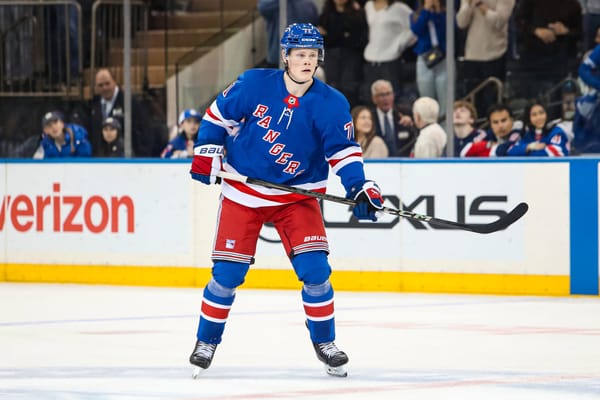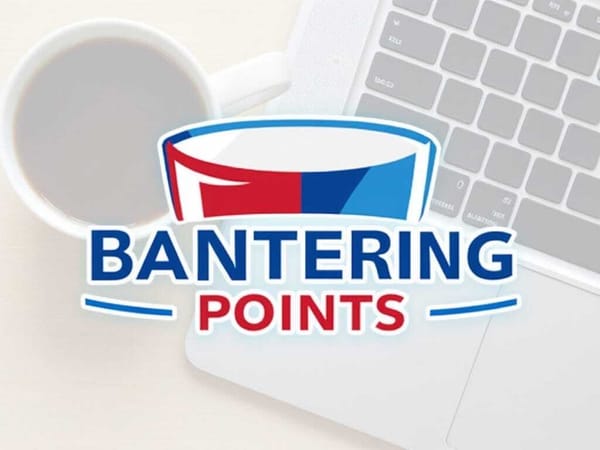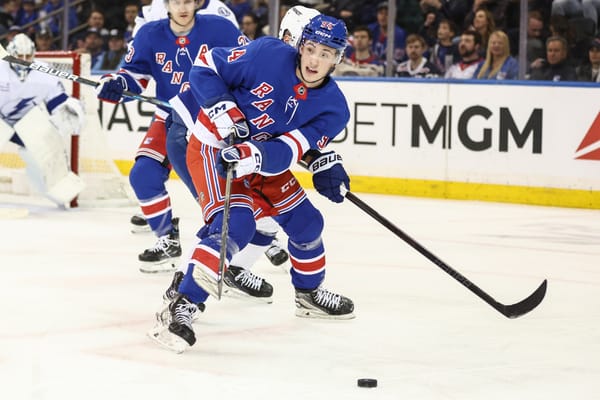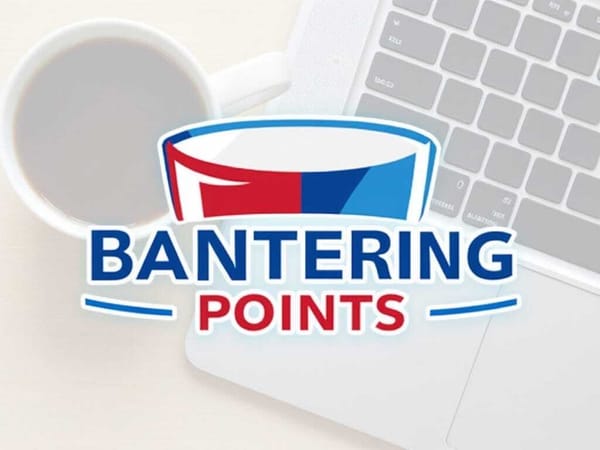New York Rangers Should Test Market of Mika Zibanejad
The Rangers are rebuilding, and there are still mammoth dominoes waiting to fall. Zibanejad is an asset that could yield a sizable return.
It is an an unpopular opinion, but the New York Rangers should gauge the market for their number one center Mika Zibanejad. If there’s a suitable offer available, they should trade him as soon as possible.
Yes, the Rangers should try and trade the same Mika Zibanejad who has a reasonable contract, nine points in nine games, and is coming off his biggest game of the season after starting off slow. When it comes to the concept of trading Zibanejad, in the words of Michael Corleone, “it’s not personal, it’s strictly business.” The business the Rangers are in is rebuilding, and Zibanejad is one of their top assets. It may seem like an odd move to make given his talent and age, but it isn’t in the context of the rebuild.
Zibanejad is 25 and will turn 26 on April 18, shortly after the completion of the regular season. Then on July 1, 2019, a no-movement clause will go into effect in the contract signed in July 2017 (it couldn’t have gone into effect until he had seven years of NHL experience).
On July 1, 2019 a no-movement clause will go into effect because he will have seven years of NHL experience. Players move from a restricted status to an unrestricted status after seven years of NHL service or once they turn 27.
Zibanejad’s NMC is for the remainder of his time with the Rangers, which includes ages 26, 27, and 28 seasons with him becoming a UFA at age 29. Given the center depth currently in the system, not even including the potential of landing Jack Hughes with the number one pick this year, it is very unlikely that the team would re-sign him — especially to remain their number one center.
History shows that a player peaks between ages 22 and 25 with a steady drop curve arching downward after and becoming steeper in post age-30 seasons (check out Part 1 and Part 2 of “A New Look at Aging Curves for NHL Skaters” from the Evolving Wild twins for the full context). Granted it is just one approach, but in the most basic sense it isn’t hard to see the Rangers cutting bait at the end of his term given the other young centers within the organization currently, and the ones they will potentially draft. Especially since he may look for a raise when their current prospects look for extensions, and his role could change as he ages. So, at the very least, Zibanejad could be done with the Rangers at the end of the 2021-22 season.
Although NMCs and NTCs have been waived before, it is easier for a team to get a deal done before they go into effect. Players have preferences on where they want to play, and that can hamstring a general manager from getting a return they deem to be acceptable. The Rangers encountered this when Rick Nash wanted to join them in 2012, and later when Martin St. Louis finally was granted his wish of becoming a Ranger in 2014 after initially requesting a trade back in 2009.
Such clauses going into effect can also create pressure for a general manager to make a move before they are valid, as we saw in the case of Derek Stepan. I say this because conversations with the Arizona Coyotes, his landing spot, and the Rangers were ongoing for a year.
Coyotes GM John Chayka hold court with media. Says he's been bugging Jeff Gorton about Stepan for a year trying to get him
— Pierre LeBrun (@PierreVLeBrun) June 23, 2017
And yet a deal didn’t get finalized until the NHL draft, a little over a week before Stepan’s NTC was set to go into effect. There’s been no official confirmation that his impending clause was the reason for the deal, but it’s very fair to assume that it played a part. The transaction also opened up significant cap space which was then filled by the signing of Kevin Shattenkirk. The takeaway here is that if there’s a good move to be made, great. If not, it may be better to wait and work with the player to find a fit that is mutually beneficial.
In the case of Zibanejad moving him now has to do with the fact that his talent is likely to be wasted on the Rangers. The team is currently 3-5-1 with seven points and sits in last place of the Metropolitan Division. The team is off to a predictable start under freshman coach David Quinn, but 2019-20 may not to be much better. Things should start to get brighter in 2020-21 and beyond, and that is contingent on youngsters like Filip Chytil, Lias Andersson, Vitali Kravtsov, Libor Hajek, K’Andre Miller, Yegor Rykov, Igor Shestyorkin, and assorted others taking on large roles with the franchise.
It may sound pessimistic, but the Rangers are not going to hit a home run on all of their prospects. There will be some who underwhelm, some who exceed expectations and others who become what they are supposed to. That is something that can be said about all prospects. The object is to accumulate a ton of prospects, primarily those who get drafted early in the first round.
With that in mind, it is in the Rangers’ best interest to isolate players who are not going to be part of the future, and trade them for the biggest return possible. Adding more “lotto tickets” like prospects and draft picks will allow the team to develop a war chest of sorts. It will create competition and ensure that the best of the best ultimately make the roster.
It is expected that pending free agents like Mats Zuccarello and Kevin Hayes will draw interest this season. They will be rental players, and as such command a return that is consummate with their value unless a team gets desperate and overpays. Ideally the Rangers would get returns similar to that of what they received for Michael Grabner and Rick Nash, and that could be accomplished if they get out ahead of the market.
A player like Chris Kreider who has the remainder of this season plus an additional year, much like Ryan McDonagh last year, would seemingly draw a bigger return. And Zibanejad with three years left on his contract at a friendly rate of $5.35 million, not factoring in potential salary retention, would fetch even more. In the name of avoiding competition and potentially missing an opportunity to deal Zibanejad, it would be wise of Jeff Gorton to tell the 30 other general managers in the league that he is available.
Timing is everything, and that is what allowed the Blueshirts to acquire him in the first place. Zibanejad joined the Rangers in a deal that sent 28-year-old Derick Brassard who was fresh off a 27-goal and 58-point season to the Ottawa Senators. Over the last two seasons Brassard has averaged 17:33 a game, and has 85 points in 153 games which is a drop off from the pace he was playing at.
The fact that the Rangers were able to sell high on Brassard like they did was amazing, and they should do the same with the fruits of that trade.
The market fluctuates as the season goes on, and it’s impacted by what players are made available, and where certain teams stand among other things. For example, a team in the market for a center may be willing to pay a price for a certain player, but will pull out of a trade and ante up a bit if a superior player comes along.
So if the Rangers make Zibanejad available and a team is willing to deal a first-rounder, a decent roster player and a top prospect, they may pull that back if hypothetically Nicklas Backstrom, Mikael Granlund, or Brayden Schenn (UFAs on July 1, 2020) were made available.
There’s also the nature of injuries occurring, desperate general managers trying to salvage their job, and more which alter the market.
This year the trade deadline could be active with centers such as Matt Duchene, Jason Spezza, and Joe Pavelski among others set to hit free agency. Duchene would be the top target here, and the one most likely to move. Pavelski is an interesting name, but San Jose appears to be all in this year. Regardless, teams looking to bolster up their roster for a run at the Cup could decide to add someone with an expiring contract as a mercenary, because it gives them more flexibility. And centers depth is an area that most teams look to improve — just look at the Penguins and Golden Knights last season, or the Maple Leafs this offseason. But there may be teams that have interest in Zibanejad, but don’t want to be in a situation where they have a short window to move other pieces around to fit him in long-term.
If Zibanejad were made available now it would give teams more than enough time to assess their roster. While most deals are done at the deadline, odds are if a team likes a player in November they will also like them in February. We are in a world where teams are constantly looking to one up each other. The Tampa Bay Lightning attempted to do that by acquiring Erik Karlsson, but were unsuccessful in doing so. The Toronto Maple Leafs signed John Tavares to boost their center depth which already included Auston Matthews and Nazem Kadri. There is bound to be a team that would add Zibanejad to their roster as either a number one or two center to create some amazing depth.
The idea of trading Zibanejad isn’t an indictment on him as a player. He’s been a great addition to the team, but the nature of the game has changed. The Rangers declared their intentions to rebuild, and it’s hard for me to find a timeline that includes they being a major contender and it making sense to have him on the roster.
Related
Breaking Down How Jeff Gorton Blew It Up
There is also the risk of Zibanejad becoming untradeable or becoming a diminished asset if he were to suffer another major injury, particularly a concussion.
After various googlings on the subject, this appears to be Mika Zibanejad's history of concussions, or suspected concussions ("upper body injuries"):
— HockeyStatMONSTER🎃 (@HockeyStatMiner) September 16, 2018
Jan 2012 (SEL)
Apr 2012 (SEL)
Dec 2013
Mar 2014
Dec 2015
Nov 2017
Six concussions by age 25 is concerning, and something the Rangers likely keep in mind. After his November concussion, he admitted he was rusty and tentative, and that it took him a little while to get back to speed. His concussion history is also something to keep in mind in the context of keeping Kevin Hayes, but that is another story for another day.
In short, Mika Zibanejad is an extremely talented and dynamic player... for the 2018-19 New York Rangers. He is very valuable to the team, but as time goes on his value becomes greater as an asset than it could be as a player on the Rangers. By no means should the team settle when it comes to a trade, though. If the value isn’t there he should stay, but they shouldn’t be opposed to the idea. At the very least, opening up dialogue could cause a chain reaction which results in other players becoming available.
If the Rangers are serious about rebuilding, they are going to be forced to make more tough decisions. They are going to have to evaluate their youngsters at the NHL level, and right now things are crowded on the front. So much so that Lias Andersson is in Hartford and Filip Chytil is playing on the wing.
Odds are that the front office would love to see a center depth chart including Chytil, Andersson, and Brett Howden sometime soon, and that won’t happen as long at the team has players like Zibanejad, Hayes, Vladislav Namestnikov, and Ryan Spooner among others blocking their paths on the roster.
The Rangers roster is bound to lose key players over the next few months, but that doesn’t mean they won’t gain any either. It has been widely reported that Artemi Panarin is interested in joining the Rangers, and NHL sources told The Athletic that the Blueshirts are Panarin’s top choice.
Make it so... pic.twitter.com/Dj1Kph0Iw0
— Tom Urtz Jr. (13 days till🇺🇸 Election Day) (@TomUrtzJr) August 24, 2018
There is always the chance it falls through, but I bring this up to those who say that trading players like Zibanejad will result in the Rangers’ roster resembling that of some recently terrible Buffalo Sabres teams. While they are rebuilding, it isn’t going to last forever and there are bound to be a number of players open to the opportunity of performing in front of the big lights of Broadway and helping to end a Stanley Cup drought that currently sits at 25 seasons.
Zibanejad’s departure would be another loud and clear message that the team is laying a foundation for future contention, and would weaken the current roster toward improving draft position.
You may disagree and say that it is way too early to have this conversation, and you might be right. All I know is that it is usually better to move an asset a year early as opposed to a year late. Dealing him would be tough, but ultimately could be one of the best decisions Gorton makes, assuming the return is there.
Stats via Hockey-Reference unless otherwise noted. Financial information via Cap Friendly.





